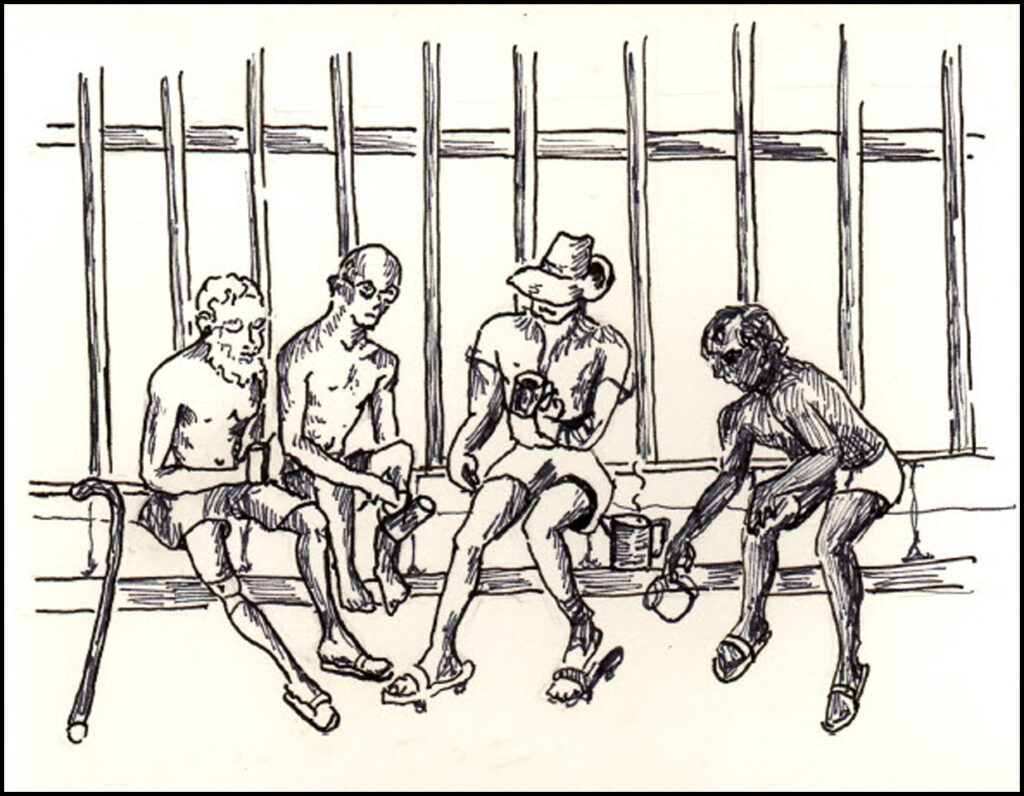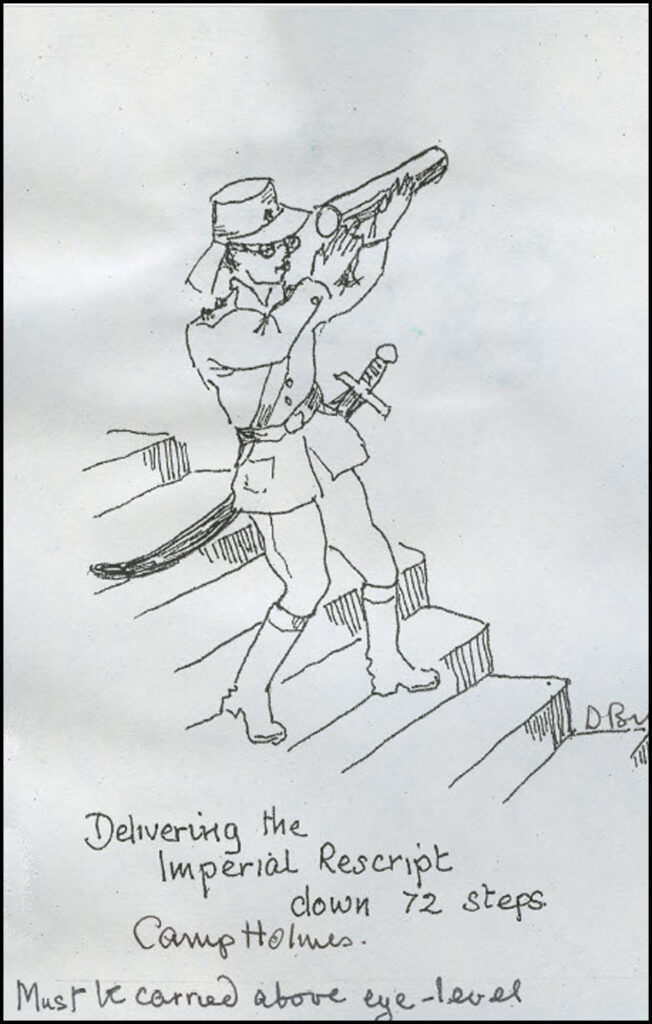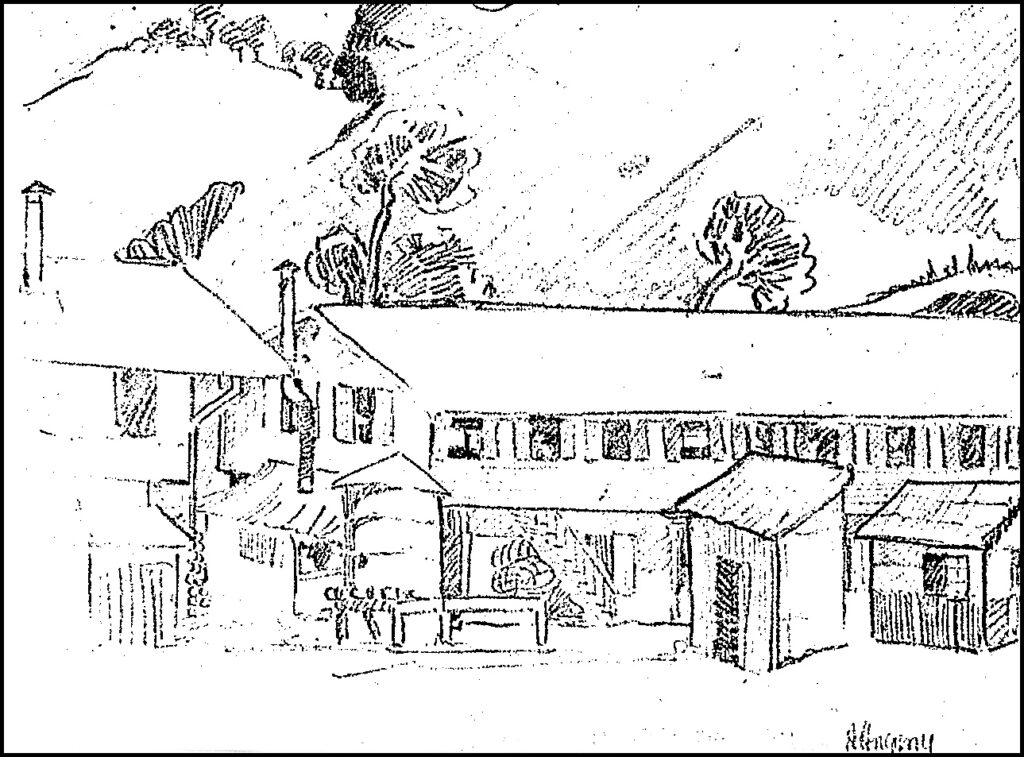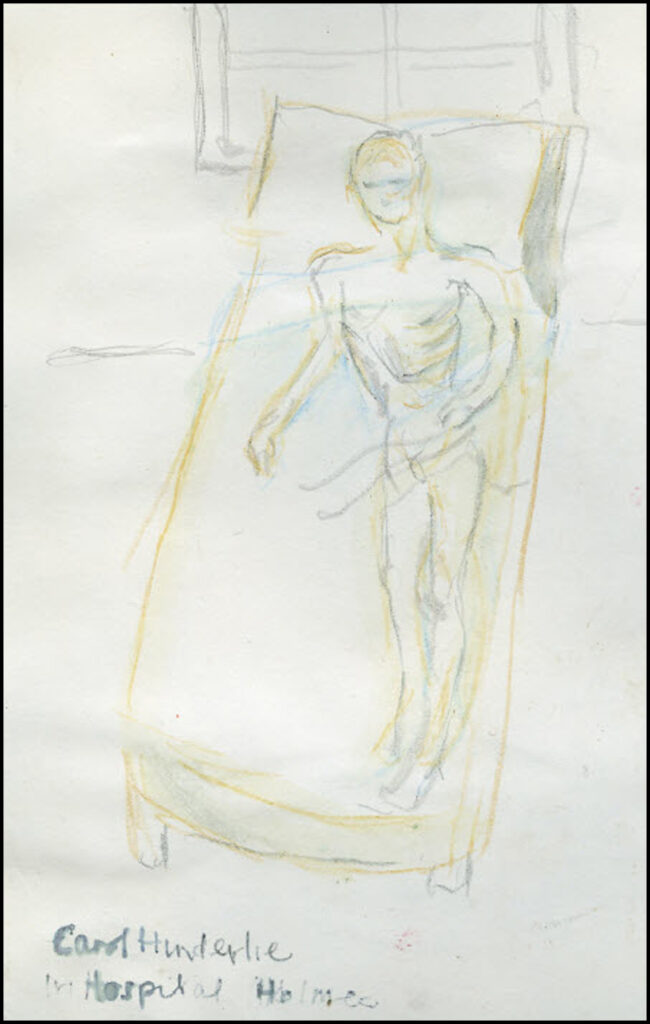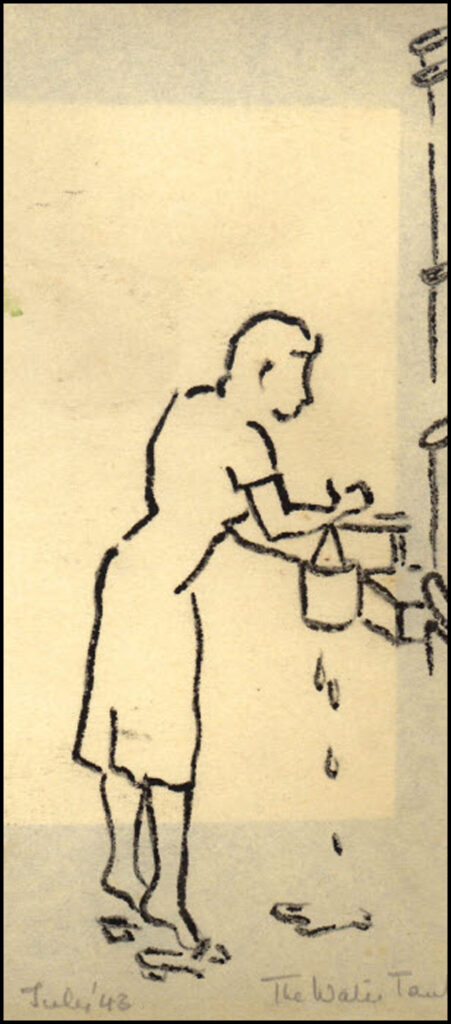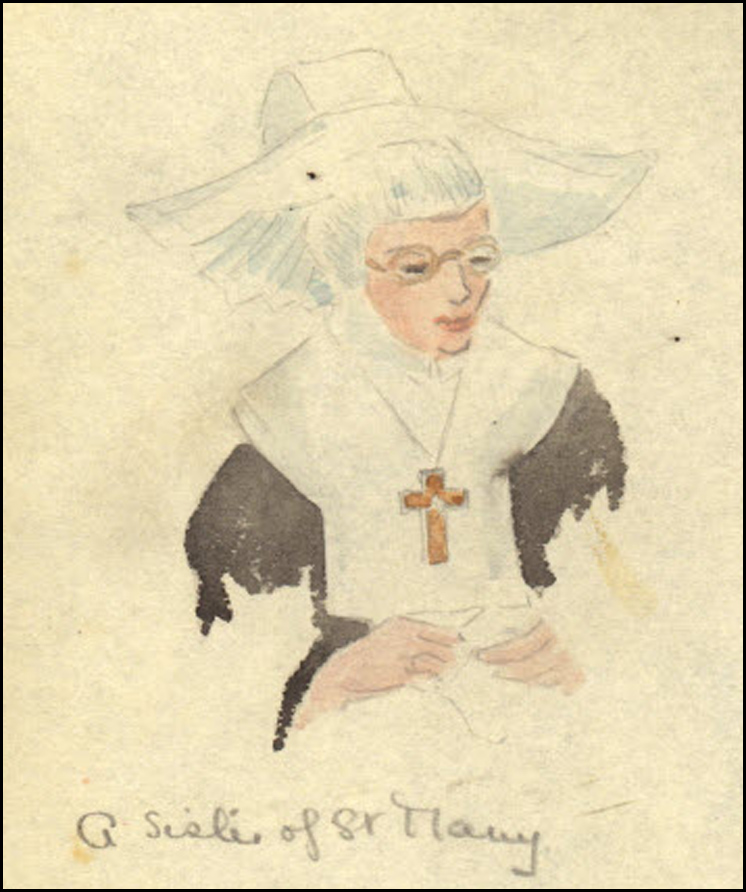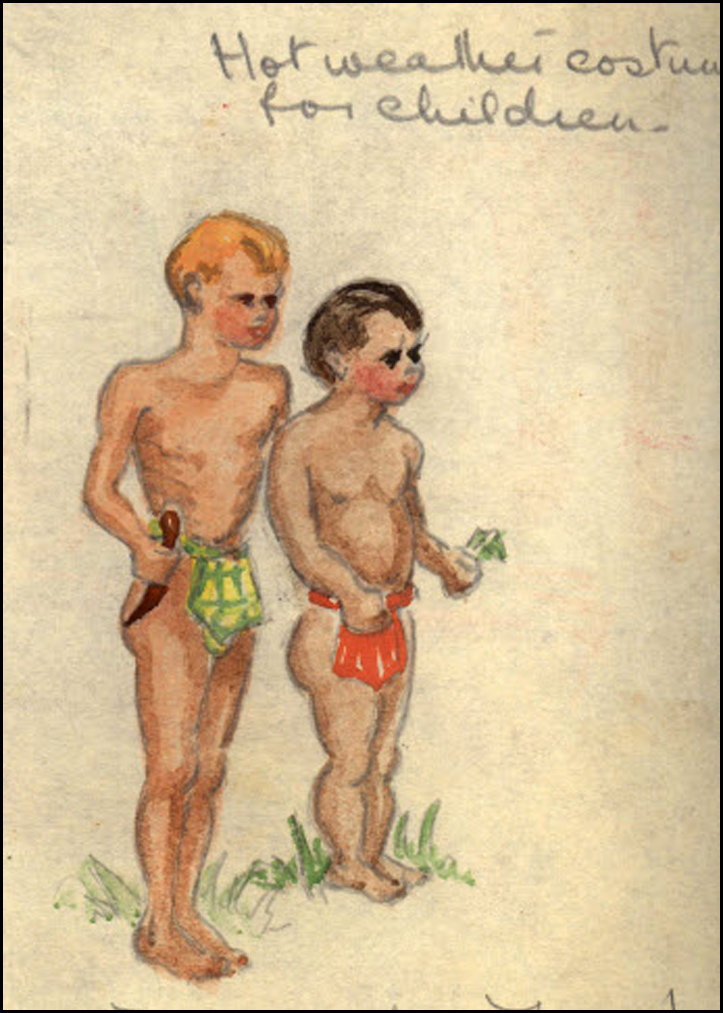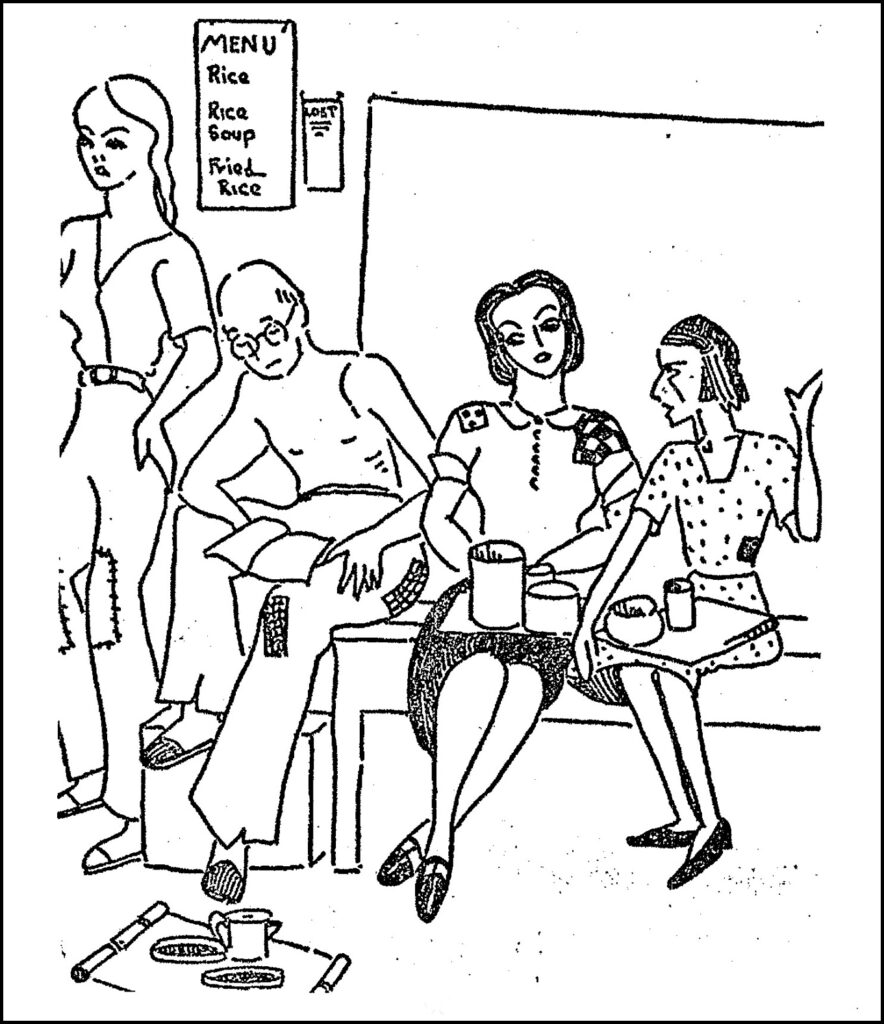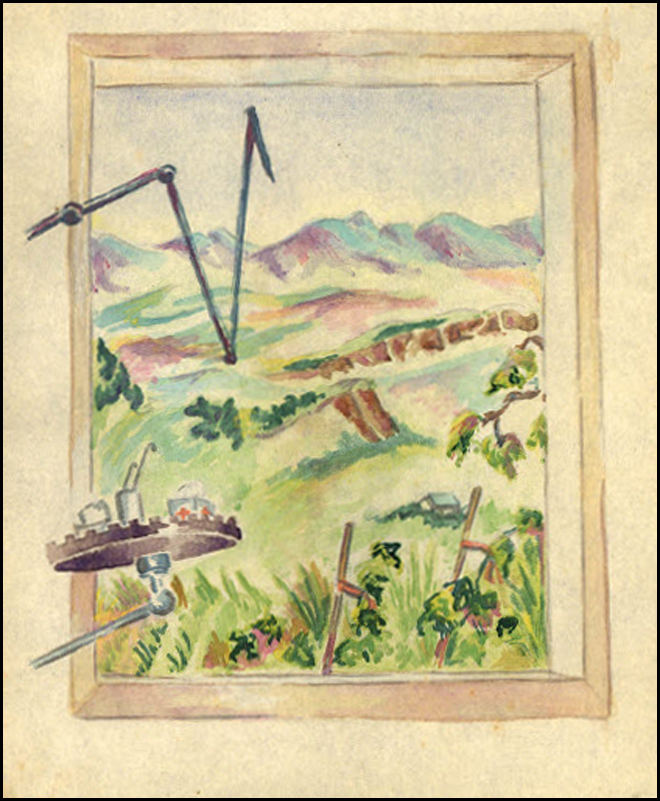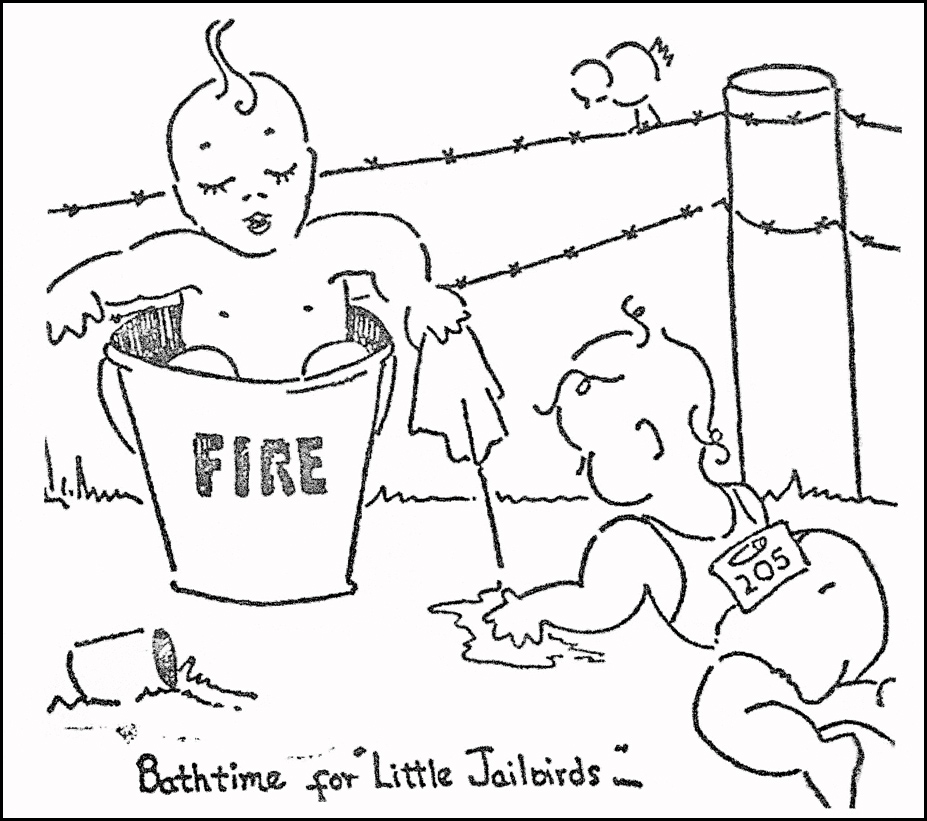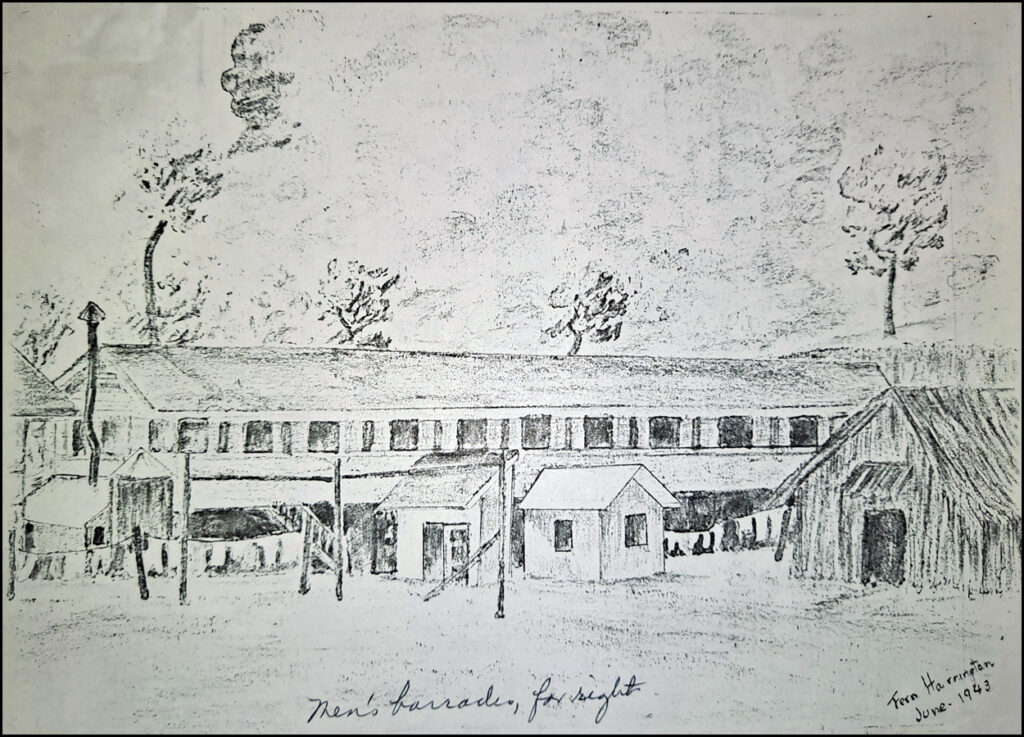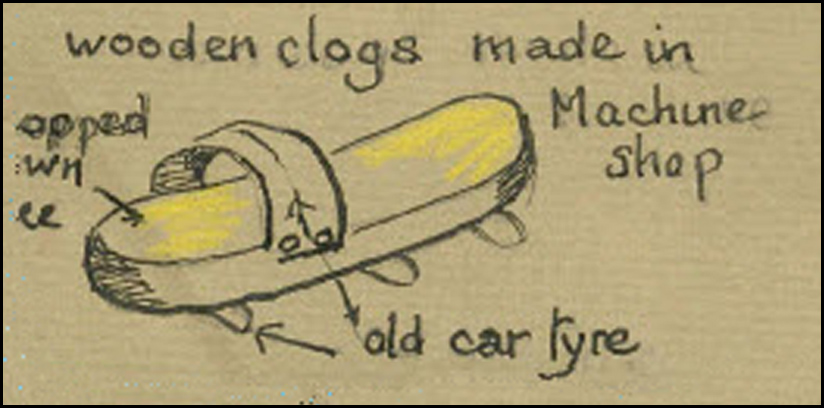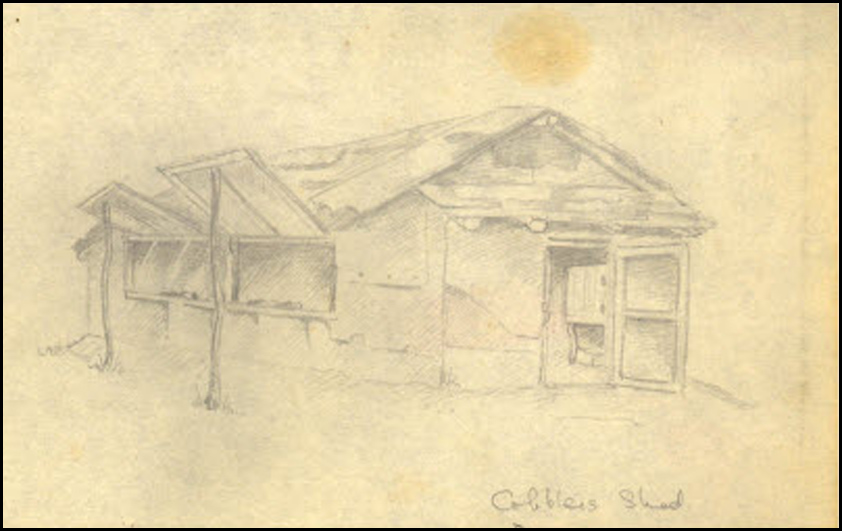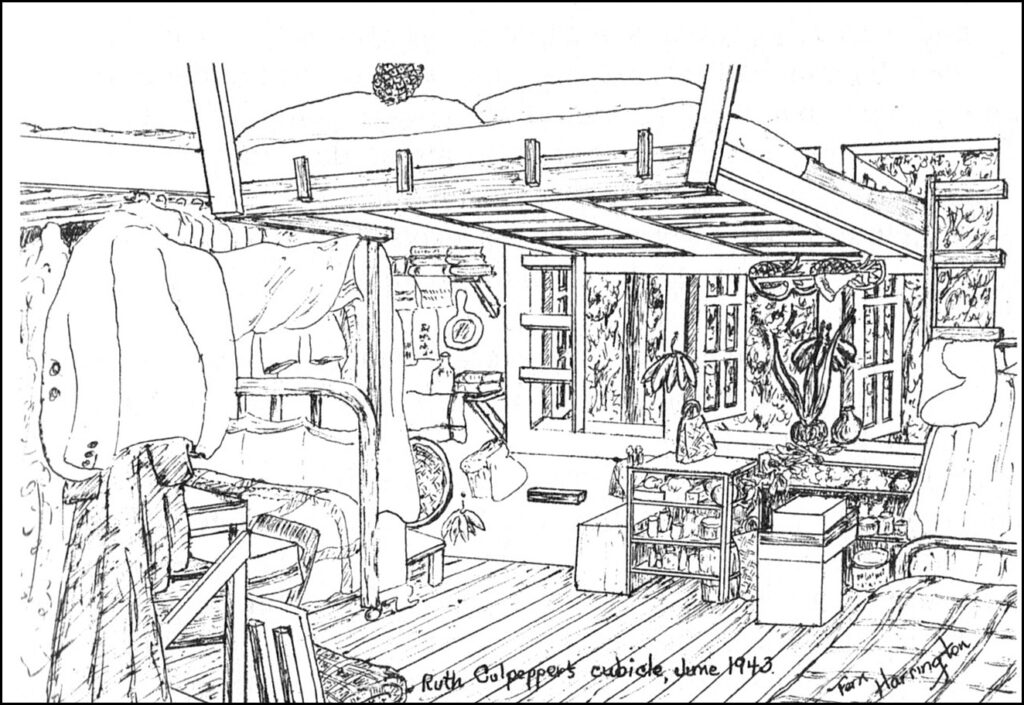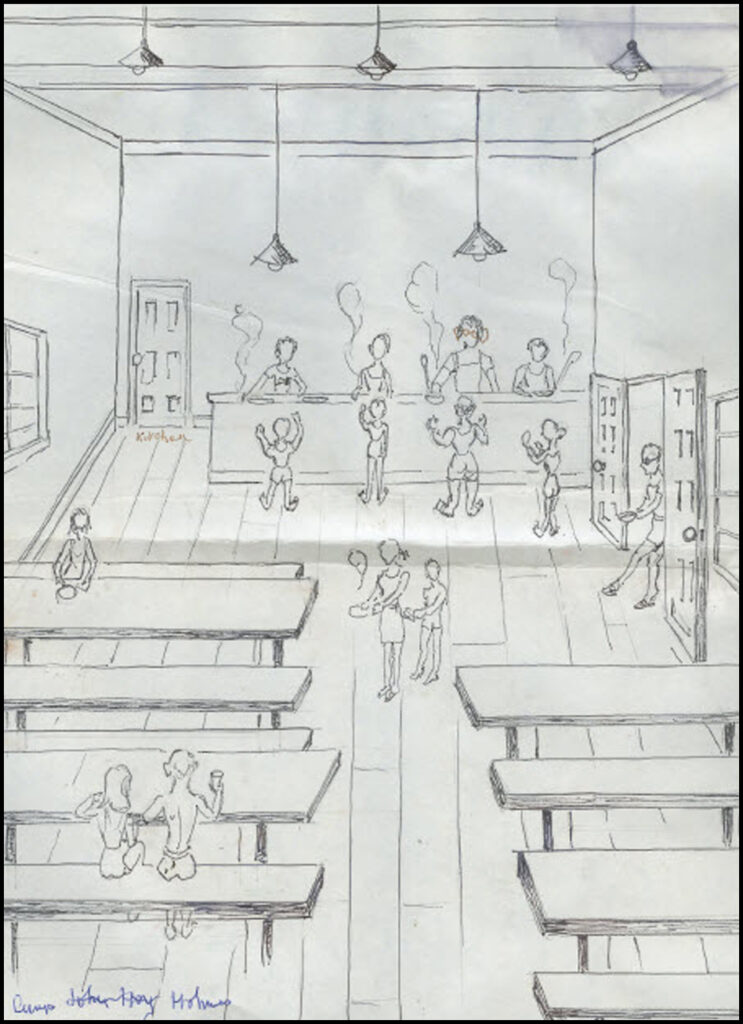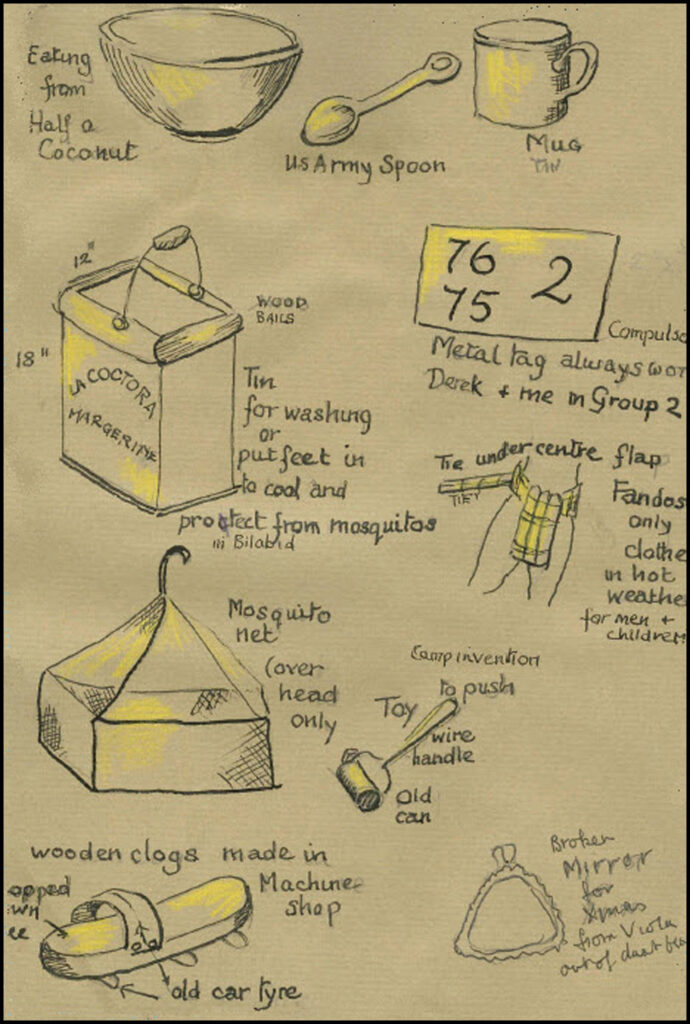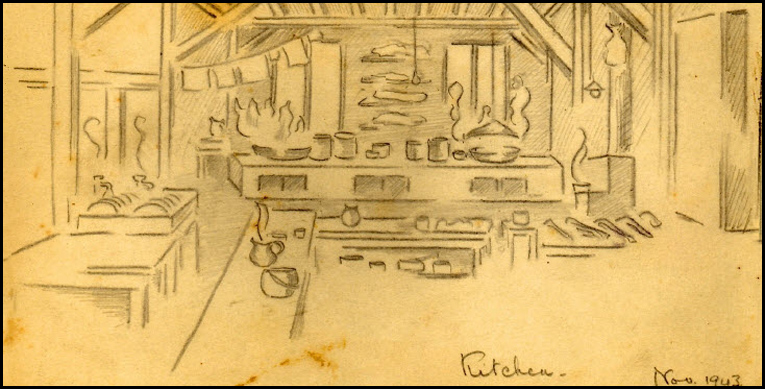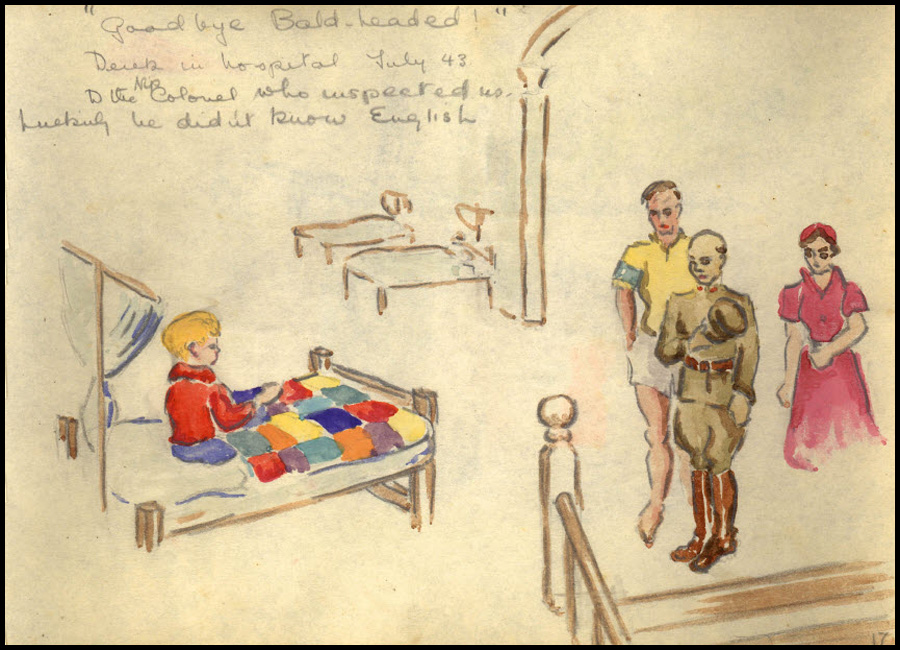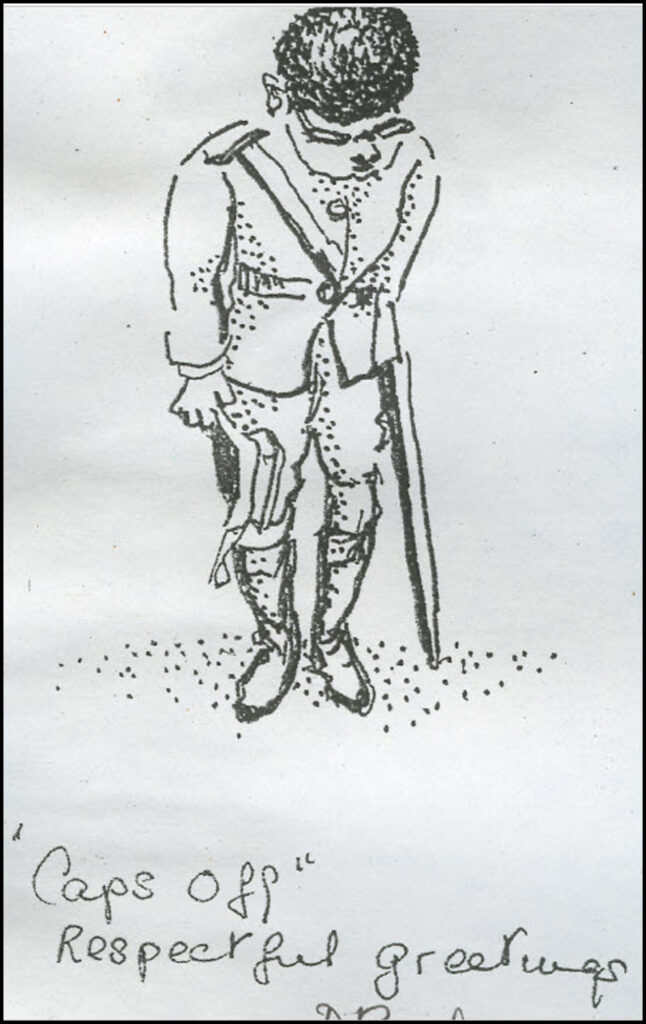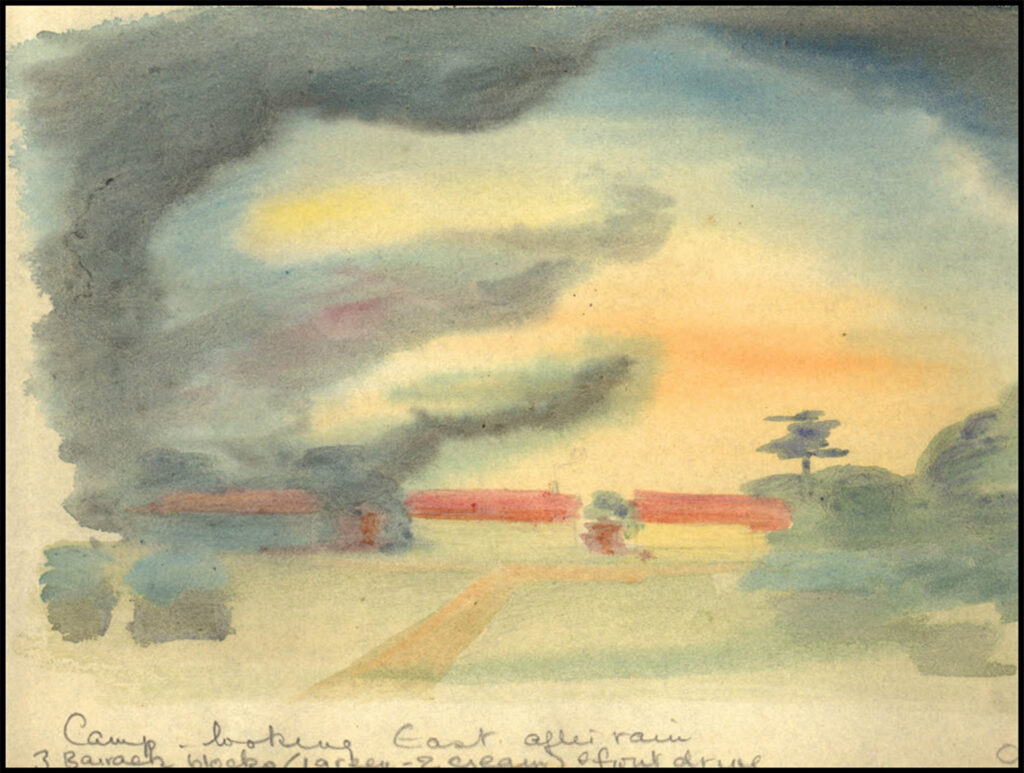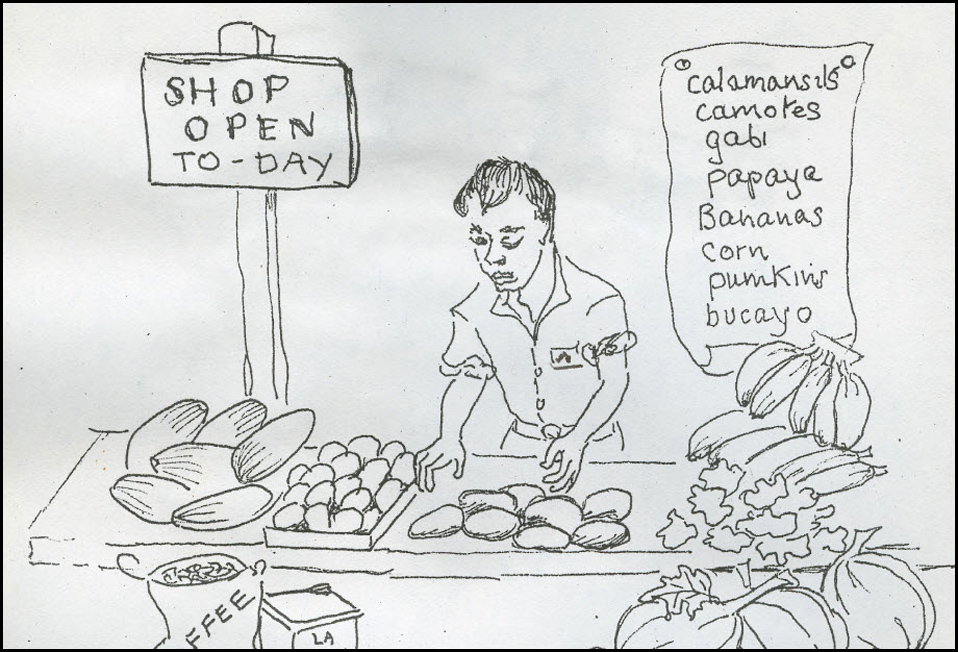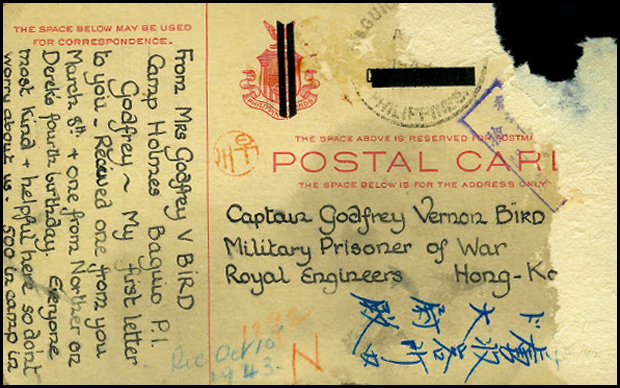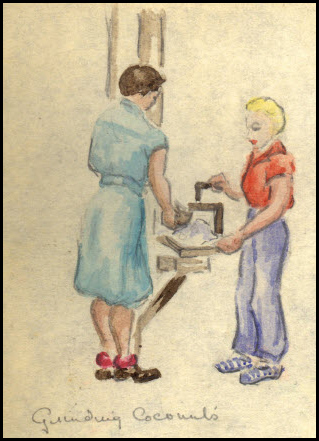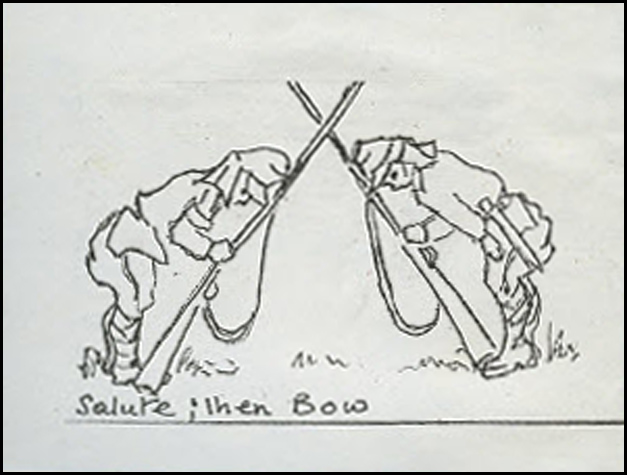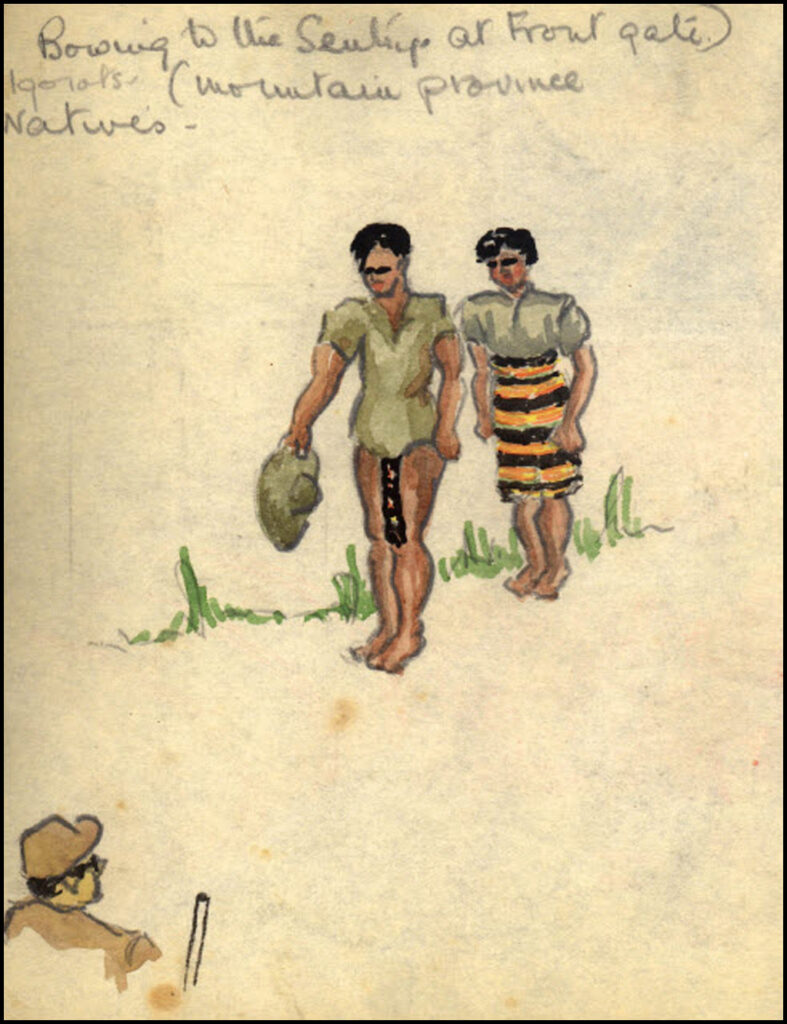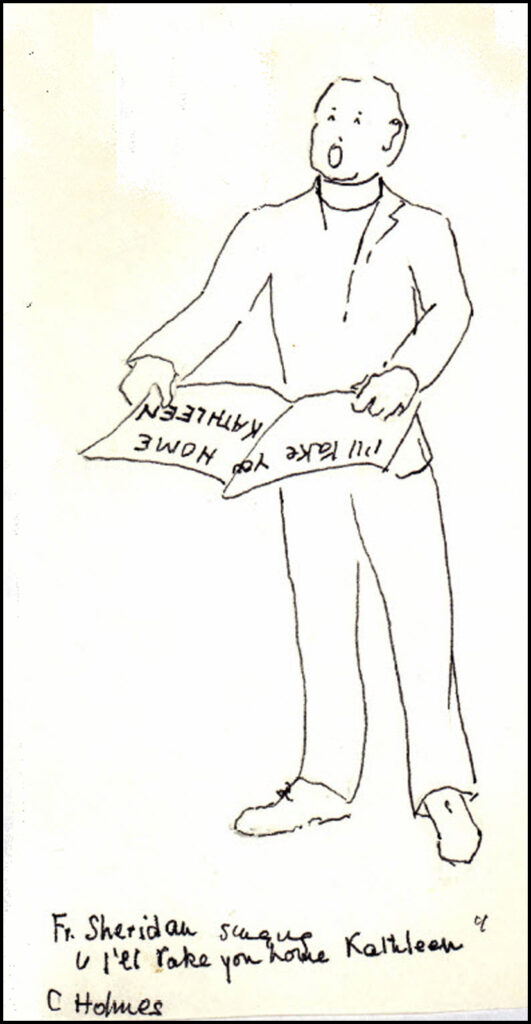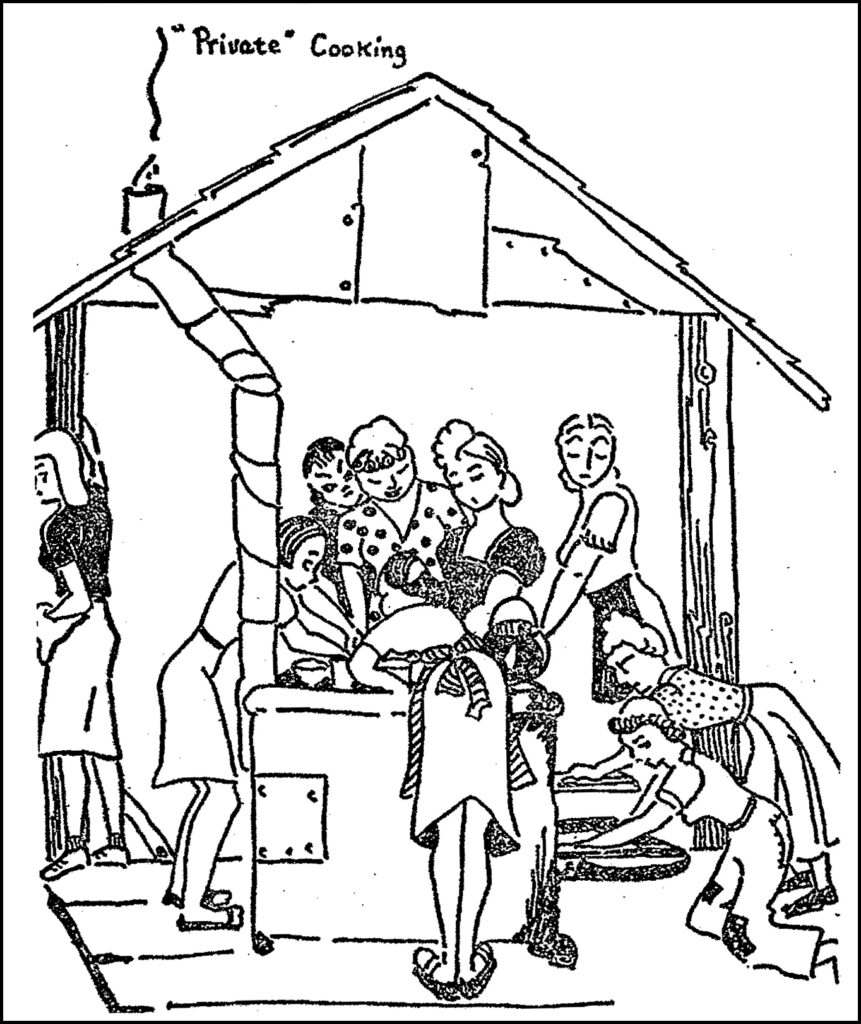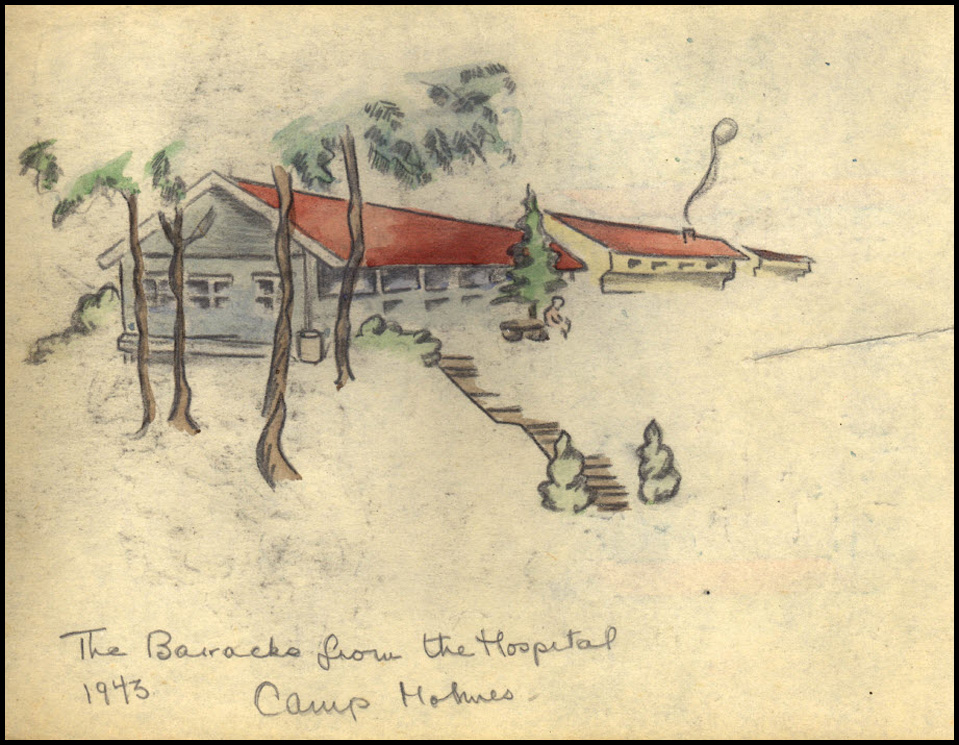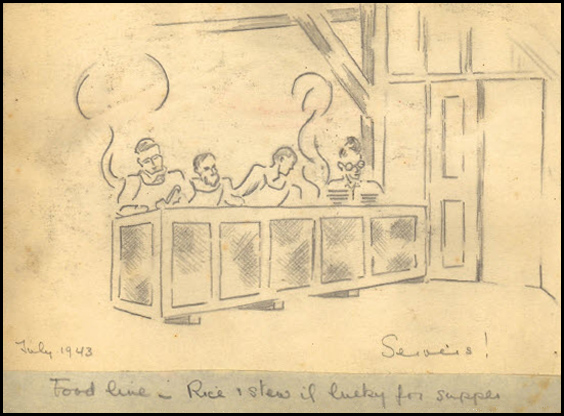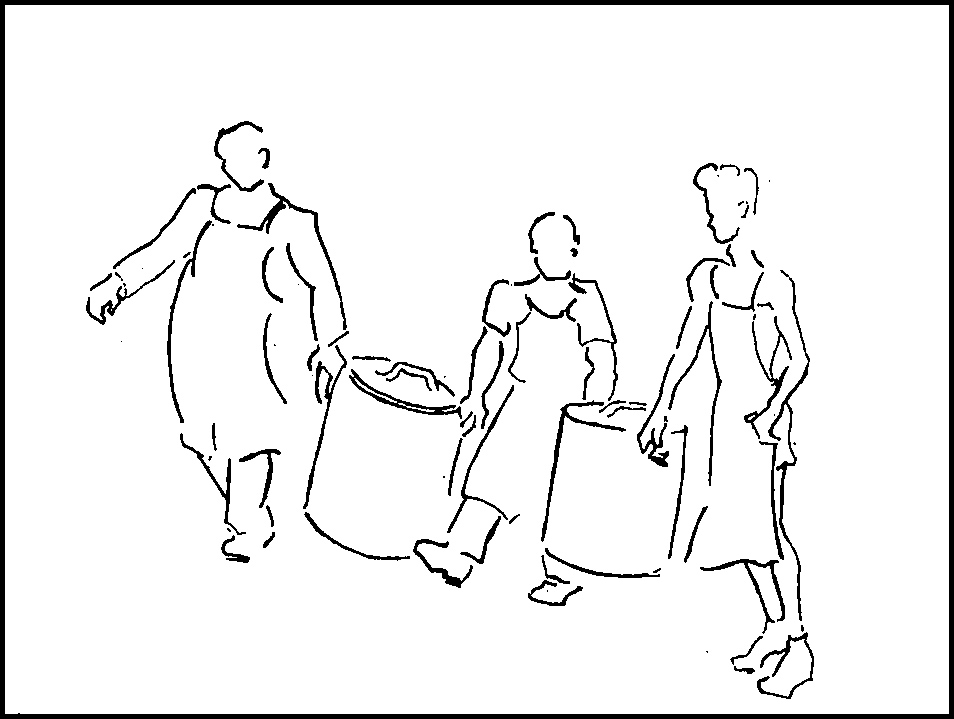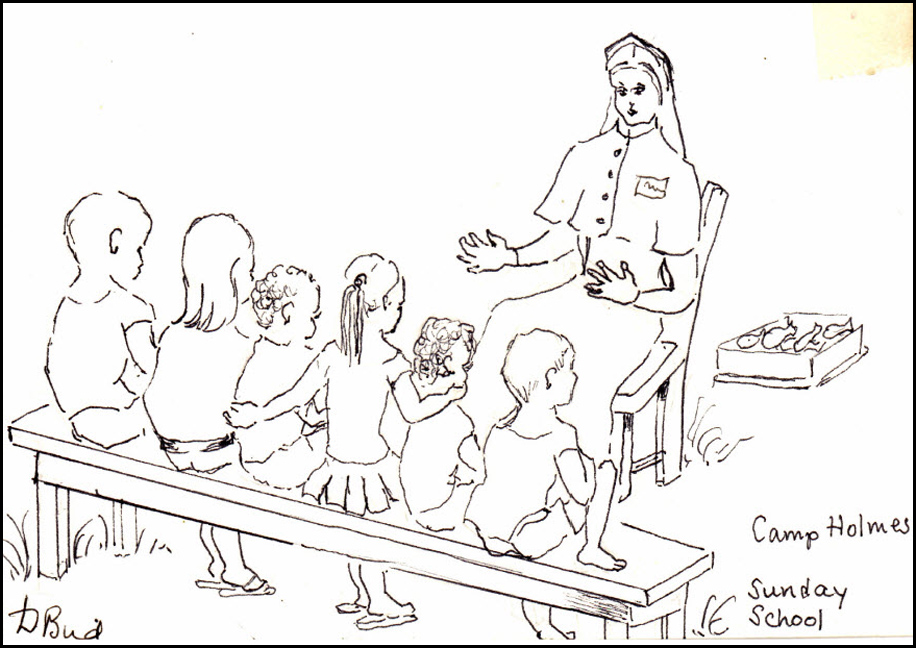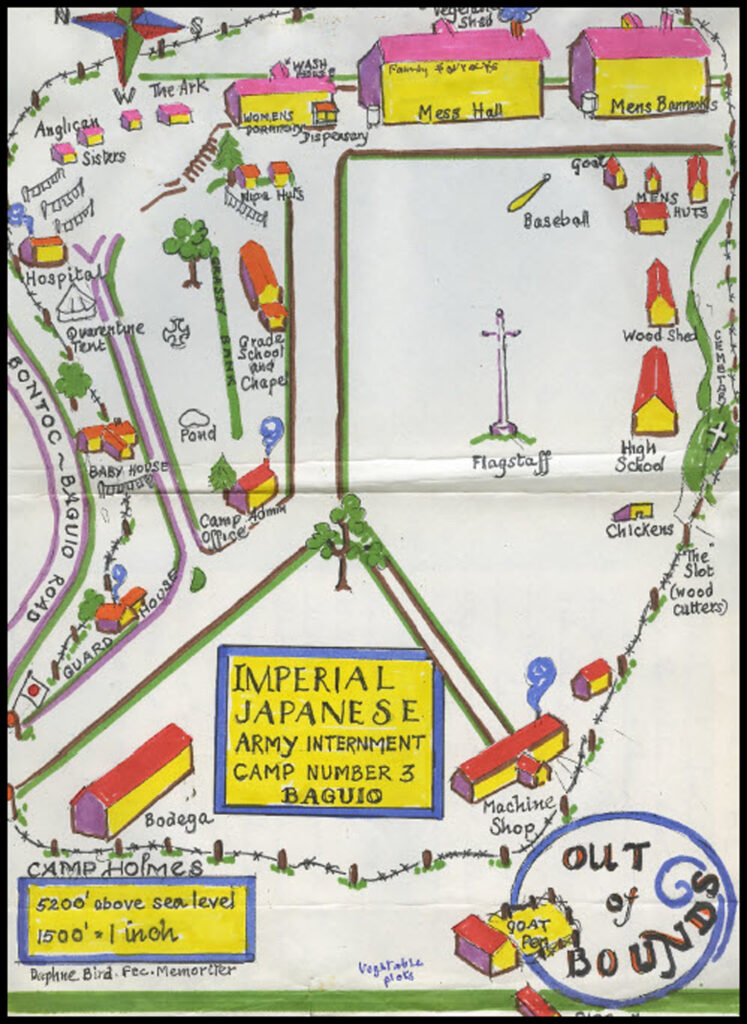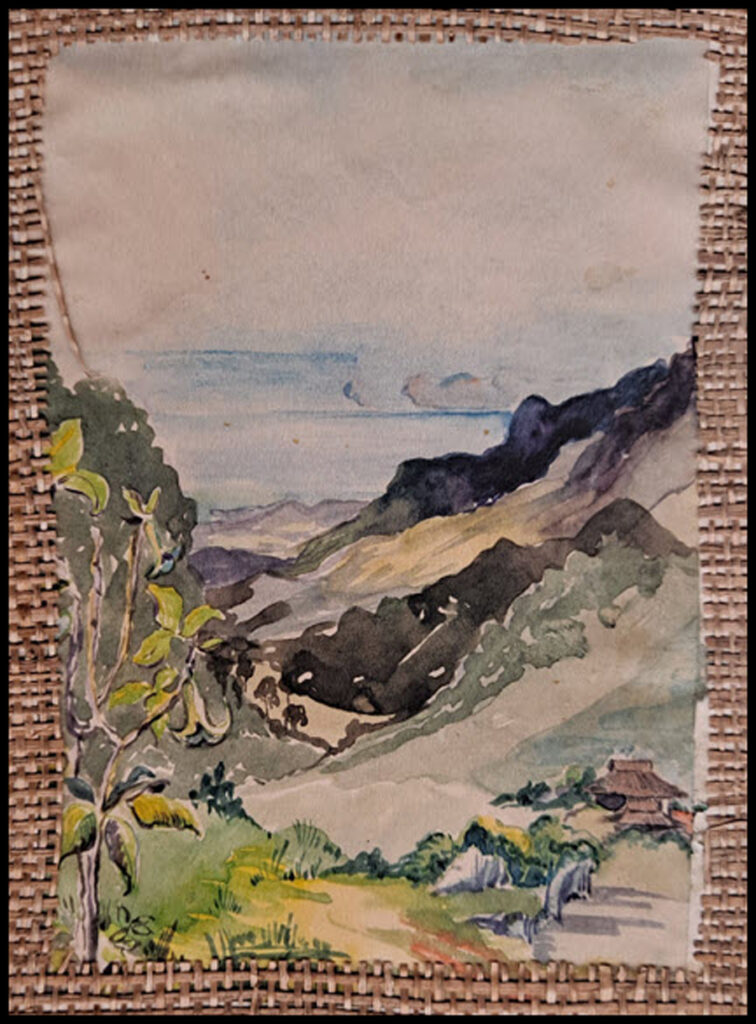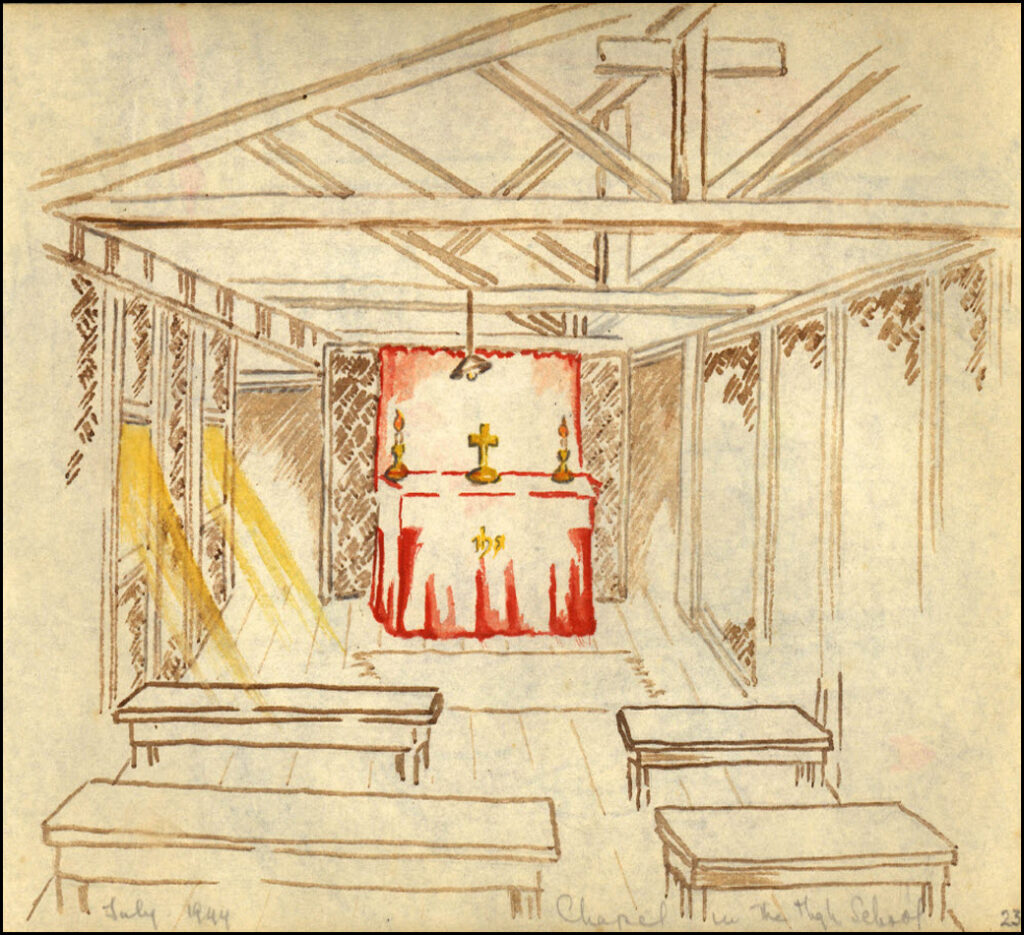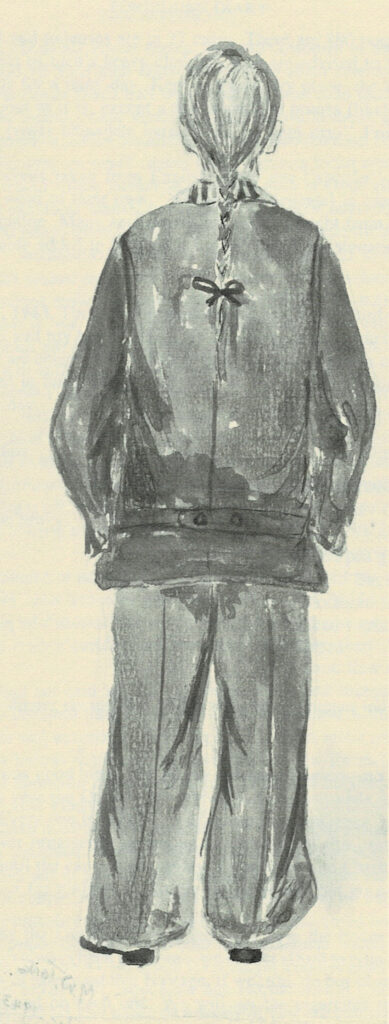Listen to Forbidden Diary
Season Three: 1943

The Complete Season Three
Binge all seven episodes in Season Three without the recaps. Does not include epilogues. NEW! Click See Pictures below to view pictures drawn by internees.
1943 - Episode 14: Going Bananas
Another year of close quarters has prisoners getting on each other’s nerves as they deal with new waves of dysentery. Stories are filtering in from captured internees who had been hiding in the mountains from the Japanese. Mr. Hayakawa is intimidated by a new guard who may be Kempeitai. Phil’s brilliant, new invention keeps peace in the dining hall.
NEW! Click See Pictures below to view pictures drawn by internees.
To read more about the artists, click on their pictures.
(Above) Sketch by Daphne Bird of men drinking “submarined” coffee. She wrote, “Submarine coffee. Could be 2, 3, or 4th (cooking) submarine of same grounds. Coffee was grown locally. Tin cups with handles made in the Machine Shop, old
beer cans with handles as mugs. If no coffee, maize could [be] cooked.”
(Above) Sketch by Daphne Bird of Japanese officer “Delivering the Imperial Rescript.” Natalie did not mention this ceremony but perhaps the “much-vaunted ‘new’ fraternity between officers and soldiers in the Japanese Army” that Natalie wrote about (Episode 14) came from a rescript.
(Above) Sketch by Helen Frances Buehl Angeny of the men’s barracks at Camp Holmes.
(Above) Drawing of dysentery patient in Camp Holmes’ hospital by Daphne Bird.
(Above) Sketch by Daphne Bird of woman filling pail at the Camp’s water tank.
(Above) Drawing of Sister of St. Mary by Daphne Bird.
1943 - Episode 15: Surrender and Suffrage
The Japanese order Arthur to hunt down an American hiding in the mountains. Newly captured Americans tell harrowing stories about their life on the run. Nida worries about Ismael. Lt. Mukibo and Mr. Nagatomi get their just rewards. Everyone speculates if Mr. Hayakawa will be replaced, and the women in Camp want the right to vote.
NEW! Click See Pictures below to view pictures drawn by internees.
To read more about the artists, click on their pictures.
(Above) Daphne Bird’s drawing of Camp children in Igorot-style clothes.
(Above) Helen Frances Buehl Angeny’s drawing of the Camp’s “chow line.” Note her commentary on the predominantly rice menu.
(Above) Painting by Daphne Bird of the view from the Camp’s dentist chair.
(Above) “Bathtime for Little Jailbirds” drawn by Helen Buehl Angeny.
(Above) Sketch of the Camp Holmes men’s barracks by Fern Harrington Miles.
1943 - Episode 16: Social Studies
Natalie takes a closer look at everyone’s behavior in camp. New internees share unforgettable stories of heroism and evil. Peg hears word about her husband. The Crouters learn disturbing news about Nida and don’t like Bedie’s reaction to it. Natalie plays a curious round of bridge with Lt. Kira, and the Camp’s new Court of Appeals hears its first criminal trial.
NEW! Click See Pictures below to view pictures drawn by internees.
To read more about the artists, click on their pictures.
(Above) Sketch by Daphne Bird of the wooden clogs made in Camp.
(Above) Cobbler shed drawn by Daphne Bird.
(Above) Sketch by Fern Harrington Miles showing one of the “suspended beds” Natalie wrote about that were “the talk, hammer and pound in the barracks.”
(Above) Camp Holmes dining hall drawn by Daphne Bird.
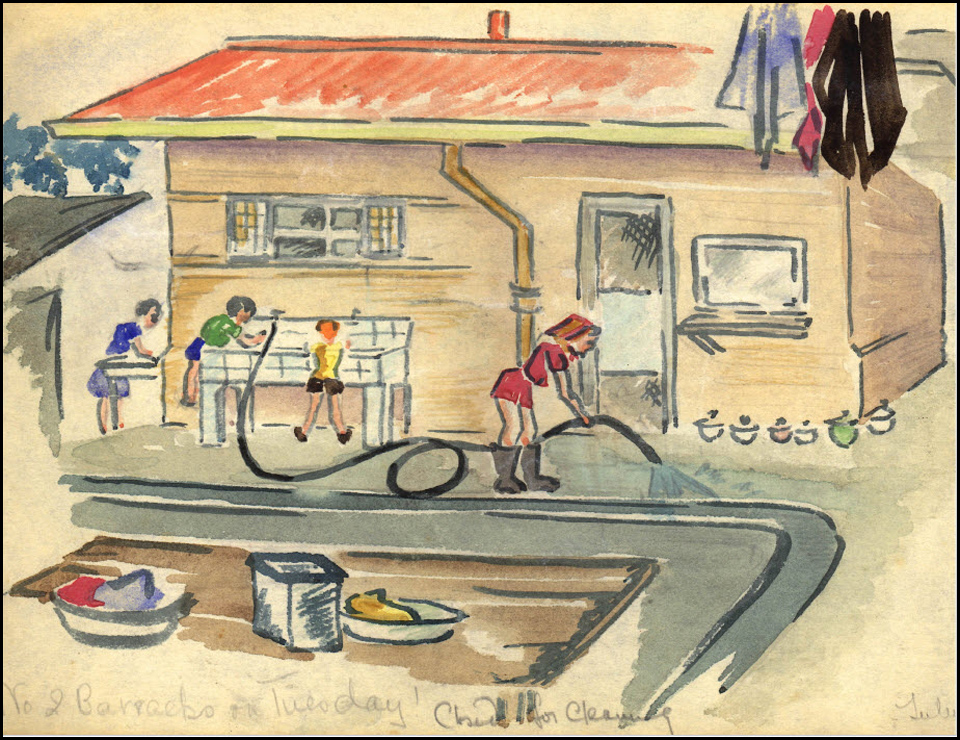
(Above) Drawing by Daphne Bird described as “No. 2 Barracks on Tuesday! Closed for Cleaning.”
Episode 16 Epilogue: Interview with MacArthur Memorial Archivist
Historian and archivist, Jim Zobel talks from the MacArthur Memorial Library about the events in the first half of 1943 with General MacArthur inching closer to Japan. Find out what happened to the two generals in the Clark Field fiasco (Episode 2 Epilogue) and hear how the larger-than-life personalities fighting WWII clashed to America’s advantage. Zobel uses “you can’t make this stuff up” stories to describe how divisions between the Army and the Navy and animosity between Generals and Admirals kept the Japanese guessing and helped to win the war. Added to the mix, Zobel tells one incredible story after the other about guerrillas, clandestine submarine landings and civilian rescues.
1943 - Episode 17: We're in the Money!
With Japanese occupation money losing value and food shortages, internees take out promissory loans for American dollars after the war. It’s “spend it while you got it” around Camp, and those with money throw elaborate parties while other internees raise money by selling homemade goods at a Camp fair. The guards worry about their fates as they hear news of American advancements in the Pacific.
NEW! Click See Pictures below to view Occupation money, June’s commencement certificate, and pictures drawn by internees.
To read more about the artists, click on their pictures.
(Above) Drawings of internees’ everyday items by Daphne Bird.
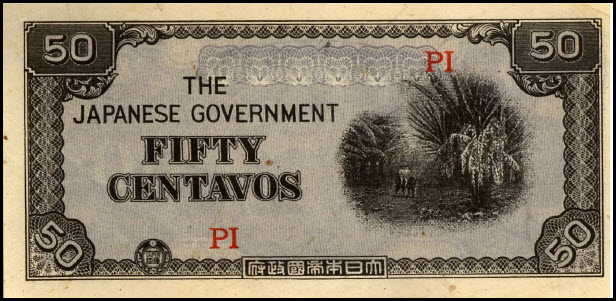
(Above) Japanese occupation money. Courtesy of the MacArthur Memorial.
(Above) Sketch of Camp Holmes kitchen by Daphne Bird.
(Above) Painting by Daphne Bird of a Camp inspection by Japanese officer. The child in bed is her son, Derek.
(Above) Picture of Japanese officer by Daphne Bird who wrote, “‘Caps Off.’ Respectful greetings.”
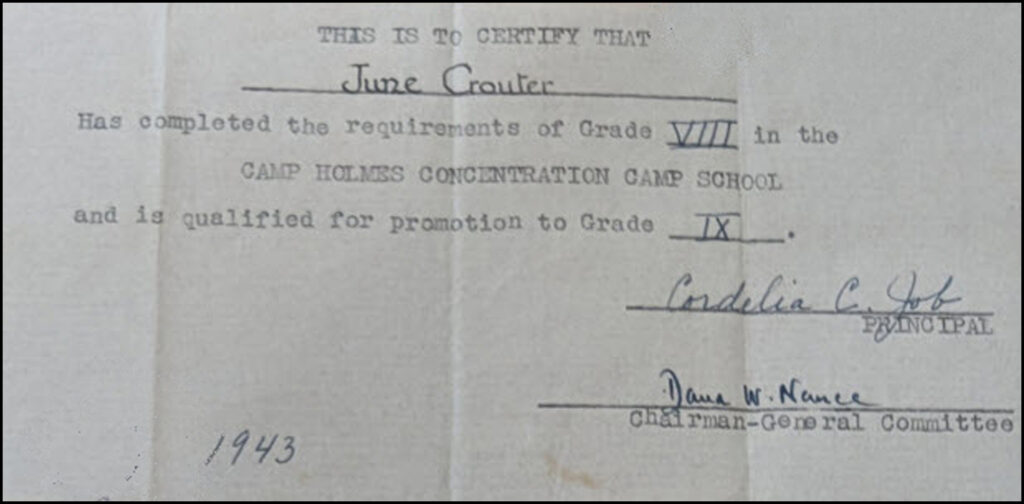
(Above) June’s commencement certificate into high school. Courtesy of the Crouter Family and the Schlesinger Library.
(Above) Painting by Daphne Bird of “Camp looking east after rain.”
(Above) Sketch by Daphne Bird who wrote, “Those who had money (not the Brits ) could shop here. Camp Holmes only.” Note that calamasis are similar to limes, camotes to sweet potatoes, gabi to potatoes, and bucayo to brown sugar.
1943 - Episode 18: Our Camp
The prisoners are finally allowed to send letters. As Natalie types for them, people pour their hearts out to loved ones at home. The increased clampdown on guerrilla activity affects Nida and Ismael living in Baguio. Peg misses her husband. A guard steps out of bounds at the women’s barracks. A friend dies. The Camp puts on two plays.
NEW! Click See Pictures below to view internee correspondence and pictures.
To read more about the artists, click on their pictures.
(Above) Daphne Bird’s postcard to her husband who was imprisoned in Hong Kong.
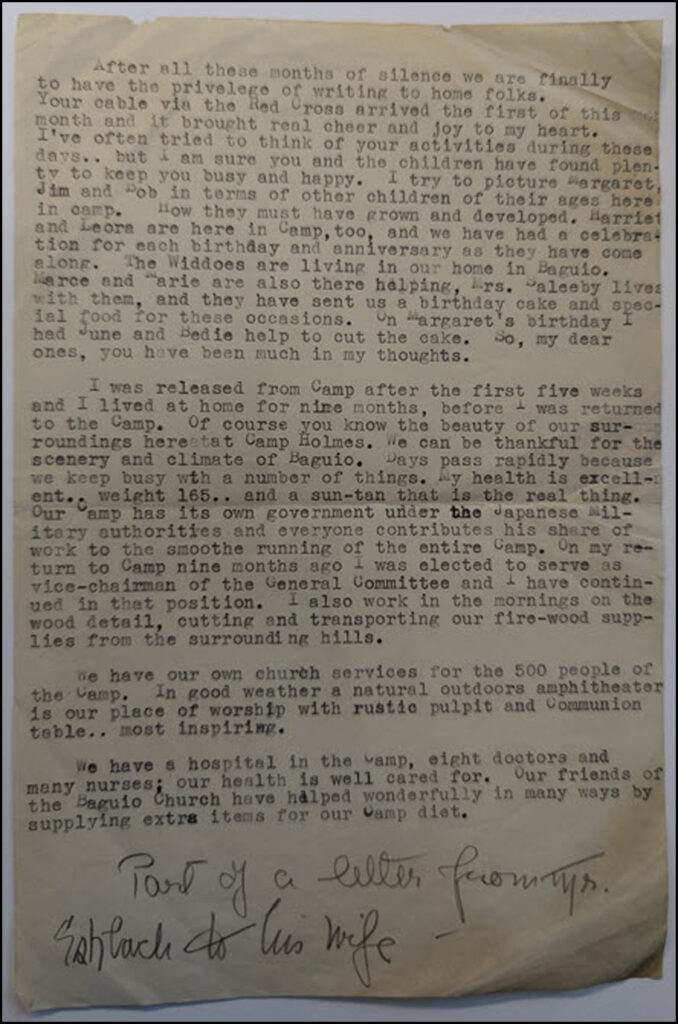
(Above) Letter Natalie may have typed for Carl as described in Episode 18. Courtesy of the Crouter family and the Schlesinger Library.
(Above) Painting of internees grinding coconuts by Daphne Bird.
(Above) Painting of the garbage crew by Daphne Bird who wrote that the men in the picture were “miners, missionaries, newspaper man and a doctor.”
(Above) Daphne Bird sketch of Japanese soldiers bowing to each other.
(Above) Daphne Bird drawing of an Igorot man and woman bowing to the sentry at Camp Holmes’ front gate.
(Above) Daphne Bird’s sketch of Fr. Sheridan singing at Camp Holmes Entertainment night. She wrote, “Anyone who could sing, act, etc., took part on Friday nights.”
Episode 18 Epilogue: Internment Survivor Interview, Part 2
In the second of three parts, 96-year-old Curt Brooks talks about life at Santo Tomas, a civilian internment camp in Manila which housed 3700 prisoners. In this segment, Curt describes his boyhood memories of imprisonment and survival—of sickness, starvation, friendship, life-saving Red Cross packages and looking down the barrel of a Japanese soldier’s rifle. (Part One can be heard by listening to the Episode 6 Epilogue.)
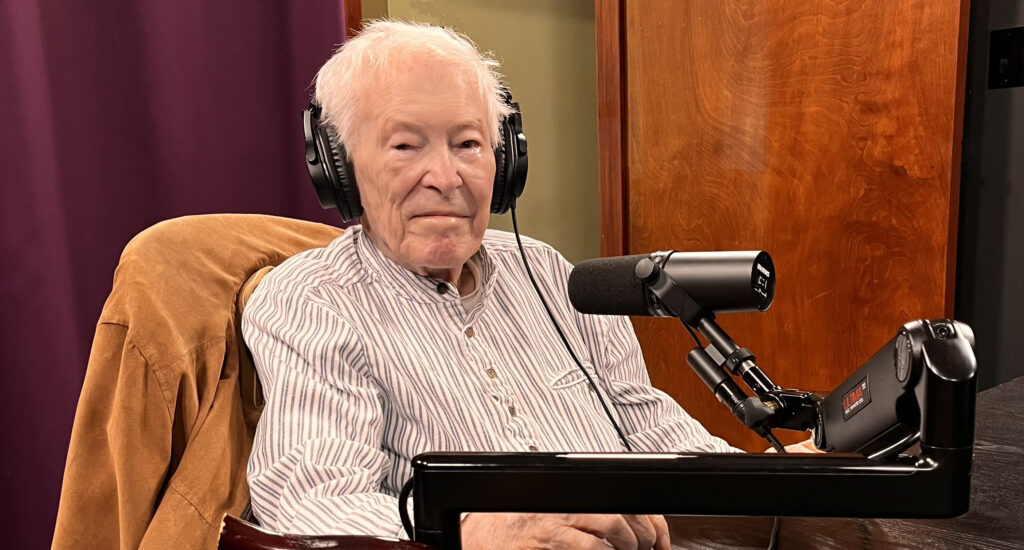
(Above) Curt Brooks at a recording studio in Las Vegas.
1943 - Episode 19: Gaining and Losing Ground
America is gaining ground in the Pacific. The prisoners have more money for food, but it’s becoming scarcer and more expensive. Everyone’s health is declining. Natalie’s vitamin injection goes wrong. Carl returns from an inspection tour of internment camps in Manila with good news. Peg thinks that her husband will be transferred to Camp Holmes, and the Camp’s shop produces an unexpected little surprise.
NEW! Click See Pictures below to view pictures drawn by internees.
To read more about the artists, click on their pictures.
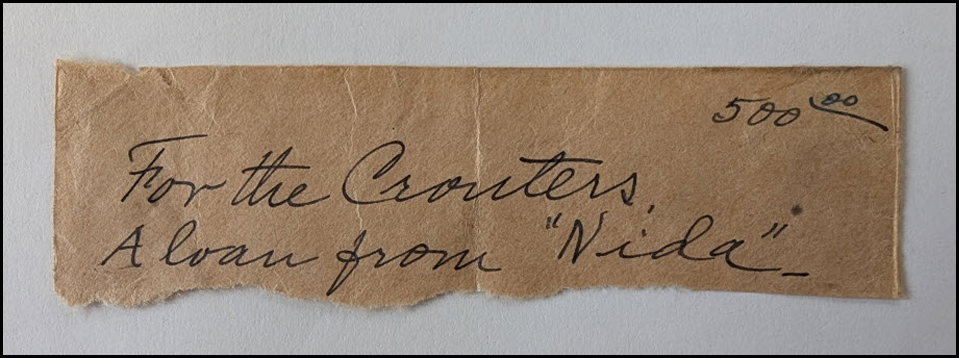
(Above) The loan note from Nida. Courtesy of the Crouter Family and the Schlesinger Library.
(Above) Picture of the women’s stove entitled “Private Cooking” by Helen Frances Buehl Angeny.
(Above) Drawing by Daphne Bird of the Camp Holmes Barracks as viewed from the Camp’s hospital.
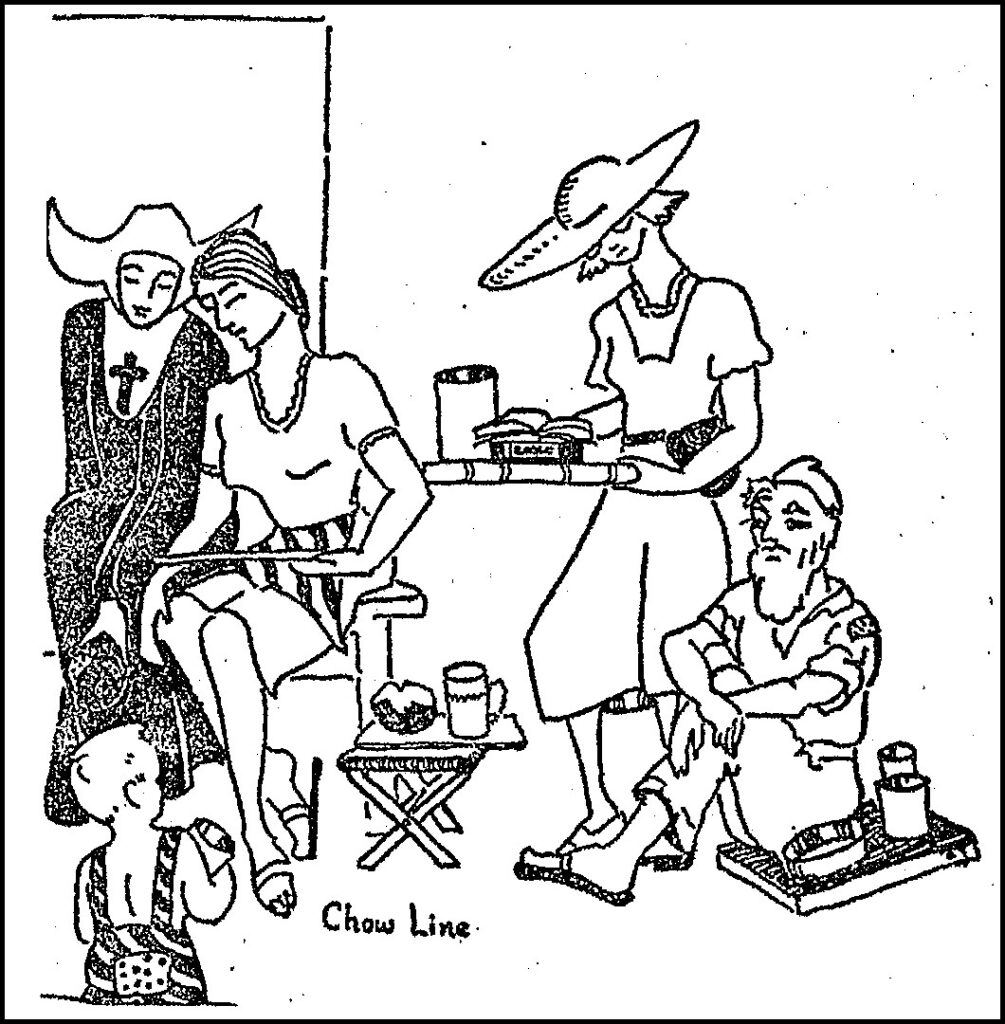
(Above) Camp Holmes “chow line” by Helen Frances Buehl Angeny.
(Above) Sketch of dining hall servers by Daphne Bird.
1943 - Episode 20: Red Cross Rescue (SEASON FINALE)
The Camp hospital runs out of beds for dysentery patients. Bedie is discharged too soon from the hospital causing Natalie and Jerry to question the Camp’s health care. Food shortages reduce good pickings from the garbage as prisoners pray that the Red Cross Christmas kits will arrive from Manila. Nida’s world is turned upside down, and Camp Holmes gets a new commandant.
NEW! Click See Pictures below to view pictures drawn by internees.
To read more about the artists, click on their pictures.
(Above) Sketch by Daphne Bird.
(Above) Drawing of Camp Sunday school by Daphne Bird.
(Above) Camp Holmes map by Daphne Bird.
(Above) View of Lingayen Gulf from Camp Holmes painted by Helen Frances Buehl Angeny.
(Above) Drawing by Daphne Bird of the Camp’s chapel which doubled as a school.
(Above) Peg’s “pigtail sketch” of Natalie that Natalie gave Jerry for Christmas in 1943.
